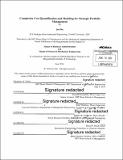| dc.contributor.advisor | Donald Rosenfield and Josef Oehmen. | en_US |
| dc.contributor.author | Ma, Jan, S.M. Massachusetts Institute of Technology | en_US |
| dc.contributor.other | Leaders for Global Operations Program. | en_US |
| dc.date.accessioned | 2014-10-08T15:27:12Z | |
| dc.date.available | 2014-10-08T15:27:12Z | |
| dc.date.copyright | 2014 | en_US |
| dc.date.issued | 2014 | en_US |
| dc.identifier.uri | http://hdl.handle.net/1721.1/90756 | |
| dc.description | Thesis: M.B.A., Massachusetts Institute of Technology, Sloan School of Management, 2014. In conjunction with the Leaders for Global Operations Program at MIT. | en_US |
| dc.description | Thesis: S.M., Massachusetts Institute of Technology, Department of Mechanical Engineering, 2014. In conjunction with the Leaders for Global Operations Program at MIT. | en_US |
| dc.description | 20 | en_US |
| dc.description | Cataloged from PDF version of thesis. | en_US |
| dc.description | Includes bibliographical references (pages 59-60). | en_US |
| dc.description.abstract | This project explores portfolio management and planning through effectively reducing complexity within operations. We apply this to a major healthcare company (referred to as Company X). The anticipated launch of new molecules and formulations into the existing high mix product portfolio presents significant challenges to contain cost and maintain the standard service level of Company X. Complexity costs associated with manufacturing and supply chain activities are not entirely accounted for in direct production costs. Having transparency to these costs at a brand or SKU level would allow significant improvements in strategic decision making throughout the life cycle of a product. The work outlined in this thesis describes the development of a quantification model to capture operational complexity costs as well as an analysis of potential impact for Company X associated with implementation of the model. This is accomplished through first, identifying and prioritizing complexity cost generators; second, quantifying the costs through application of activity based accounting; third, building and piloting a decision support tool and NPV model. Lastly, process for implementation and application of the model was defined. The findings from this project provide financial rationale for a 27% reduction in the total product portfolio size, which results in a potential savings of $75M over the next five years, and 50% human resource savings across the Technical Operations and key support functions at Company X. The model can be a powerful tool for optimizing product portfolios with attention to financial, operational, and strategic considerations. Reducing complexity creates the ability to become more discerning about the portfolio composition and enable Company X to focus even more on high growth and life-saving brands. | en_US |
| dc.description.statementofresponsibility | by Jan Ma. | en_US |
| dc.format.extent | 60 pages | en_US |
| dc.language.iso | eng | en_US |
| dc.publisher | Massachusetts Institute of Technology | en_US |
| dc.rights | M.I.T. theses are protected by copyright. They may be viewed from this source for any purpose, but reproduction or distribution in any format is prohibited without written permission. See provided URL for inquiries about permission. | en_US |
| dc.rights.uri | http://dspace.mit.edu/handle/1721.1/7582 | en_US |
| dc.subject | Sloan School of Management. | en_US |
| dc.subject | Mechanical Engineering. | en_US |
| dc.subject | Leaders for Global Operations Program. | en_US |
| dc.title | Complexity cost quantification and modeling for strategic portfolio management | en_US |
| dc.type | Thesis | en_US |
| dc.description.degree | M.B.A. | en_US |
| dc.description.degree | S.M. | en_US |
| dc.contributor.department | Leaders for Global Operations Program at MIT | en_US |
| dc.contributor.department | Massachusetts Institute of Technology. Department of Mechanical Engineering | |
| dc.contributor.department | Sloan School of Management | |
| dc.identifier.oclc | 891370291 | en_US |
